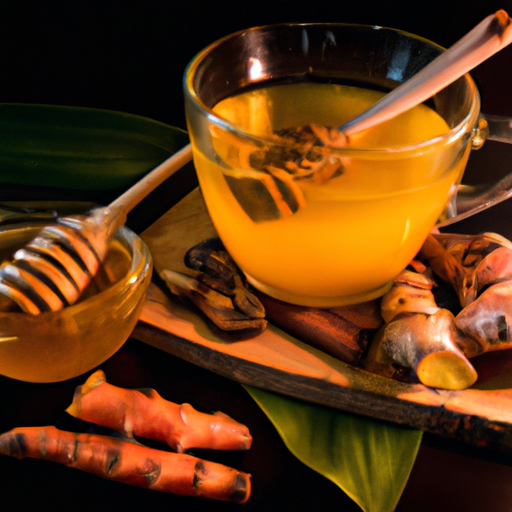Hello! Just like me, if you’re on the hunt for natural methods to boost your health and wellness, then you’re in for a treat. I’m thrilled to divulge my go-to recipe for an anti-inflammatory turmeric tea!
Turmeric has been used for centuries in traditional medicine, and recent research has shown that it may have powerful anti-inflammatory effects. In this article, I’ll walk you through the process of making a delicious cup of turmeric tea that can help reduce inflammation in your body.
We’ll start by exploring the health benefits of turmeric and gathering all the necessary ingredients. Then, we’ll move on to preparing the tea itself and discussing some tips for getting it just right. Finally, we’ll talk about how to incorporate turmeric tea into your daily routine and other ways to enjoy its benefits.
So grab a mug and let’s get started!
Key Takeaways
- Turmeric tea can help reduce inflammation in the body, improve digestion, boost immunity, and brain function
- Adding black pepper to turmeric tea can increase the bioavailability of curcumin by up to 2000%
- Ginger, cinnamon, lemon juice, honey, and dairy alternatives can be added to balance out any bitterness and create a creamy texture
- Storing turmeric tea in the refrigerator for up to 3 days in an airtight container allows for easy consumption and enjoyment.
Understanding the Health Benefits of Turmeric
I want to talk about the health benefits of turmeric and how to make an anti-inflammatory turmeric tea.
Turmeric has been found to have anti-inflammatory properties, which can help reduce inflammation in the body and potentially improve conditions such as arthritis.
It also has antioxidant properties, which can protect cells from damage caused by free radicals.
In addition, there are other potential health benefits of consuming turmeric, such as improving brain function and reducing the risk of heart disease.
To make an anti-inflammatory turmeric tea, simply steep turmeric powder or grated fresh turmeric root in hot water and add honey and lemon to taste. Enjoy!
Anti-inflammatory properties
You can enjoy the anti-inflammatory benefits of turmeric by adding it to your tea. Turmeric contains a compound called curcumin, which has been shown to have strong anti-inflammatory properties. Inflammation is the body’s natural response to injury or infection, but chronic inflammation can lead to a variety of health problems such as arthritis, heart disease, and cancer.
Incorporating anti-inflammatory foods and lifestyle changes into your daily routine can help reduce inflammation in the body. In addition to its anti-inflammatory properties, turmeric also has antioxidant properties that can help protect the body from damage caused by free radicals. Free radicals are unstable molecules that can cause oxidative stress and damage cells.
Antioxidants neutralize free radicals and prevent them from causing damage. Drinking turmeric tea regularly may help boost your overall antioxidant levels and improve your health in various ways.
Antioxidant properties
Boost your body’s protection against free radicals with the antioxidant properties found in this golden spice. Turmeric contains a compound called curcumin, which has powerful antioxidant effects. Curcumin neutralizes free radicals and helps prevent oxidative damage to cells, reducing the risk of chronic diseases such as cancer, Alzheimer’s disease, and heart disease.
Turmeric supplements are available in pill form, but cooking with turmeric is an easy way to incorporate it into your diet. You can add turmeric powder to soups, stews, rice dishes, and even smoothies. For maximum health benefits, pair turmeric with black pepper – studies have shown that piperine in black pepper increases the bioavailability of curcumin by up to 2000%.
With its potent antioxidants and anti-inflammatory properties, turmeric is a versatile spice that can boost your overall health and well-being. In addition to protecting against free radicals, it also offers other health benefits such as boosting brain function and improving digestion.
Other health benefits
With its ability to give your body a helping hand, incorporating turmeric into your diet can be the cherry on top for overall health and well-being.
In addition to its antioxidant properties, turmeric has been found to have various other health benefits. Turmeric supplements have been used to alleviate joint pain and inflammation in arthritis patients. It’s also been shown to improve brain function and reduce the risk of heart disease.
Aside from supplements, turmeric is commonly used in culinary dishes such as curries and soups. Adding turmeric to your meals not only enhances their flavor but also provides potential health benefits.
With all these fantastic benefits, it’s no wonder that turmeric has become increasingly popular in recent years. Now that we know more about why this spice is so beneficial, let’s move on to gathering the ingredients for our anti-inflammatory turmeric tea!
Gathering the Ingredients
First, grab a teaspoon of ground turmeric, a pinch of black pepper, a tablespoon of honey, and a cup of water from your pantry. When selecting the ingredients for your anti-inflammatory turmeric tea, it’s important to choose high-quality ones.
Look for organic turmeric powder and raw honey to maximize their health benefits. Black pepper is added to enhance the bioavailability of curcumin in turmeric which is responsible for its anti-inflammatory properties. If you don’t have black pepper on hand or you’re not fond of its taste, you can substitute it with ginger powder instead.
Ginger also has potent anti-inflammatory effects that can complement those of turmeric. You may also add other spices like cinnamon or cardamom to give your tea an extra flavor boost. Now that you have gathered all the ingredients needed for this healthy beverage, let’s move on to preparing the turmeric tea and experience its anti-inflammatory goodness firsthand.
Preparing the Turmeric Tea
Now it’s time to combine the ingredients and create a warm, soothing beverage that’ll leave you feeling refreshed and revitalized.
To prepare the turmeric tea, start by boiling two cups of water in a small pot or kettle. Once the water comes to a boil, add one teaspoon of finely grated fresh turmeric root or one-half teaspoon of ground turmeric. Let the mixture simmer for about 10 minutes on low heat until the water turns into a deep golden color.
Then, turn off the heat and add a pinch of black pepper and honey or maple syrup to taste. Black pepper helps boost bioavailability while honey or maple syrup adds sweetness to balance out the bitterness of turmeric.
Turmeric tea benefits are numerous as it’s loaded with antioxidants and anti-inflammatory properties that help improve digestion, reduce joint pain, lower cholesterol levels, regulate blood sugar levels, boost immunity, and brain function.
You can also experiment with different variations of this recipe by adding ginger root for extra spice, cinnamon for sweetness, or lemon juice for some zing.
Now, let’s move on to tips for making the perfect turmeric tea!
Tips for Making the Perfect Turmeric Tea
When it comes to making the perfect turmeric tea, there are a few key tips that I always keep in mind.
First and foremost, using fresh turmeric root is essential for achieving maximum flavor and health benefits.
Additionally, adjusting the spice levels to your personal preference can make a big difference in how enjoyable you find your cup of tea.
Lastly, choosing the right sweetener and milk can help balance out any bitterness and create a deliciously creamy texture.
By following these simple tips, you’ll be able to brew up a delicious cup of anti-inflammatory goodness every time!
Using fresh turmeric root
To add a burst of fresh flavor, try grating a small piece of turmeric root into your turmeric tea recipe. Not only does this enhance the taste, but it also provides additional health benefits of turmeric root.
Here are four reasons why you should consider using fresh turmeric root in your next cup of tea:
-
Fresh turmeric root contains higher levels of curcumin, the active ingredient responsible for its anti-inflammatory properties.
-
It adds a bright yellow color to your tea and can make it more visually appealing.
-
Grating the root releases more flavor and nutrients than using powdered or dried forms.
-
Using fresh ingredients is always a healthier option compared to processed ones.
By incorporating fresh turmeric root into your tea-making process, you can elevate both the taste and nutritional value of your drink.
Now that we’ve covered how to use fresh turmeric root, let’s move on to adjusting spice levels for those who prefer a milder or spicier version of this delicious beverage.
Adjusting spice levels
Feeling like your taste buds need a change? Spice level adjustment is key to flavor customization in turmeric tea. Whether you prefer a subtle taste or an extra kick, adjusting the spice levels can help you achieve the perfect balance of flavors.
To adjust the spice levels in your turmeric tea, start with small tweaks and gradually increase or decrease according to your preference. The following table provides a guide for adjusting spice levels based on different ingredients:
| Ingredient | Decrease Spice Level | Neutral Spice Level | Increase Spice Level |
|---|---|---|---|
| Turmeric Powder | 1/2 tsp less | Same amount | 1/2 tsp more |
| Ginger Powder | 1/4 tsp less | Same amount | 1/4 tsp more |
| Black Pepper Powder | Pinch less | Same amount | Pinch more |
With these simple adjustments, you can create a unique flavor profile that suits your taste buds. Next up, we’ll explore how to choose the right sweetener and milk for your turmeric tea without compromising its health benefits.
Choosing the right sweetener and milk
Indulge your taste buds with the perfect sweetener and milk combination to enhance the flavor of your turmeric infusion.
When it comes to choosing a sweetener for your turmeric tea, there are several options to consider. Honey is a popular choice for its natural sweetness and added health benefits. It has antibacterial properties that can help soothe sore throats and boost immunity. Maple syrup is another great option as it adds a rich, earthy flavor that complements the spiciness of the turmeric.
If you prefer dairy alternatives, there are plenty of options available as well. Almond milk adds a nutty flavor that pairs well with the warmth of turmeric, while coconut milk brings in a touch of sweetness and creaminess. Soy milk is also an excellent alternative if you’re looking for something with a more neutral taste profile.
Experiment with different combinations until you find the one that suits your palate best.
Enhancing the flavor of your turmeric tea by selecting the right sweetener and milk is just one way to elevate your experience. Next, we’ll learn how to serve and store this anti-inflammatory brew so you can enjoy it any time of day!
Serving and Storing the Turmeric Tea
Once you’ve brewed a comforting cup of turmeric tea, it’s important to know how to properly store and serve it for the ultimate experience.
When it comes to storing options, turmeric tea can be kept in the refrigerator for up to 3 days. To ensure maximum freshness, store the tea in an airtight container or bottle. If you prefer your turmeric tea cold, add ice cubes before serving.
When it comes to serving suggestions, there are many ways you can enjoy your turmeric tea. You can drink it plain or with a slice of lemon for added flavor and health benefits. For those who like their teas sweeter, honey or agave syrup can be added as a natural sweetener. Additionally, if you prefer creamy drinks, almond milk or coconut milk can be added for a rich and smooth texture.
Incorporating turmeric tea into your daily routine is easy and beneficial. By adding this anti-inflammatory beverage to your diet regularly, you may experience improved digestion, decreased inflammation in the body, and boosted immune function. So why not make yourself a cup today and start enjoying all the wonderful benefits that come with drinking this delicious and healthy beverage?
Incorporating Turmeric Tea into Your Daily Routine
By adding this golden elixir to your morning routine, you can experience a boost in overall wellness and vitality. Turmeric tea is a great way to start the day on a healthy note.
You can make it a part of your daily ritual by incorporating it into your breakfast or mid-morning routine. One way to enjoy turmeric tea is by trying out different flavor variations. Add honey, ginger, or lemon for added benefits and taste.
Honey has antibacterial properties while ginger can help with digestion and nausea. Lemon adds vitamin C which helps with immunity. However, it’s important to note that there are potential risks and side effects associated with consuming too much turmeric.
In the next section, we will go over these risks so you can enjoy the benefits of turmeric tea without any adverse effects.
Potential Risks and Side Effects
Now that you’ve learned how to incorporate turmeric tea into your daily routine, it’s important to be aware of potential risks and side effects. While turmeric is generally safe for consumption in moderate amounts, there are some people who should exercise caution.
Firstly, those taking blood-thinning medications or with bleeding disorders should consult with their healthcare provider before consuming turmeric regularly. This is because turmeric can have a slight blood-thinning effect and may increase the risk of bleeding.
Secondly, individuals with gallbladder issues or bile duct obstruction should also use caution when consuming turmeric as it can stimulate the production of bile.
Lastly, excessive intake of turmeric has been linked to gastrointestinal issues such as nausea and diarrhea. It’s important to stick to recommended dosages and listen to your body if you experience any negative symptoms.
Overall, incorporating turmeric tea into your daily routine can provide numerous health benefits but it’s important to take precautions and be aware of potential risks. In the next section, we’ll explore other ways you can enjoy the benefits of this amazing spice without having to make tea every day.
Other Ways to Enjoy the Benefits of Turmeric
You can easily incorporate the amazing benefits of turmeric into your diet and feel healthier than ever before. Aside from making turmeric tea, you can also try other ways to enjoy this wonderful spice.
One option is to make a turmeric latte, which has become increasingly popular in recent years. This warm, comforting drink is made by mixing milk (or a plant-based alternative) with turmeric, ginger, cinnamon, honey or maple syrup for sweetness, and black pepper to enhance the absorption of curcumin.
Another way to enjoy the benefits of turmeric is by adding it to smoothies. Turmeric pairs well with fruits like mangoes, pineapples, and bananas. You can combine these fruits with some yogurt or kefir for added probiotic benefits and a creamier texture.
To make a basic turmeric smoothie recipe: blend 1 cup of frozen mango chunks or pineapple chunks with ½ teaspoon of ground turmeric powder, ½ teaspoon of freshly grated ginger root (or ginger powder), 1 tablespoon of honey or agave nectar (optional), 1 cup of unsweetened almond milk (or any milk). Add ice cubes if desired.
Incorporating turmeric into your diet doesn’t have to be complicated or boring. By trying out new recipes like the ones mentioned above – whether it’s making a latte or blending up a smoothie – you’ll be able to reap the anti-inflammatory and antioxidant benefits that this wonder spice has to offer!
Frequently Asked Questions
Can turmeric tea be consumed by pregnant women?
As a pregnant woman, I was curious about the benefits and risks of consuming turmeric tea. After doing some research, I found that turmeric has anti-inflammatory properties and can be helpful for reducing swelling and pain during pregnancy.
However, it’s important to note that high doses of turmeric may increase the risk of miscarriage or preterm labor. It’s recommended to consume no more than 1 teaspoon per day in food or drink preparations.
It’s also important to discuss any dietary changes with your healthcare provider before making them.
Can turmeric tea cause any allergic reactions?
As someone who’s experienced allergic reactions in the past, I understand the concern around consuming turmeric tea and its potential to cause allergic reactions.
While there’s limited research on this topic, it’s possible for some individuals to have an allergic reaction to turmeric.
Symptoms may include skin rash, hives, or difficulty breathing. It’s important to consult with a healthcare provider if you experience any of these symptoms after consuming turmeric tea or other products containing turmeric.
If you’re looking for alternative anti-inflammatory drinks, ginger tea and green tea are great options that can also provide health benefits.
It’s always important to listen to your body and choose what works best for you.
Can turmeric tea interact with any medications?
When it comes to turmeric tea, it’s important to be aware of any potential drug interactions. Turmeric can interact with certain medications, such as blood thinners and stomach acid reducers. It’s always best to consult with a healthcare provider before consuming turmeric tea if you’re taking any medications.
Additionally, pregnant women should also exercise caution when consuming turmeric, as there isn’t enough research on its safety during pregnancy. While turmeric has anti-inflammatory properties, it’s crucial to prioritize your health and well-being by checking for any potential risks before incorporating it into your diet.
How long should turmeric tea be steeped for optimum benefits?
For optimum benefits, turmeric tea should be steeped for at least 10-15 minutes. This allows the active ingredient in turmeric, curcumin, to fully infuse into the water and provide its anti-inflammatory properties.
However, it’s important to note that steeping time can affect the flavor profile of the tea as well. Longer steeping times may result in a stronger, more bitter taste, while shorter steeping times may produce a milder flavor. It ultimately comes down to personal preference and experimenting with different steeping times to find what works best for you.
Is it necessary to add black pepper to turmeric tea for better absorption of curcumin?
It’s a common belief that adding black pepper to turmeric tea can enhance the absorption of curcumin, the active ingredient in turmeric responsible for its anti-inflammatory benefits. However, research on this topic is inconclusive and conflicting.
Some studies suggest that piperine, the compound found in black pepper, can increase curcumin absorption by up to 2000%, while others show little to no effect. While it may not be necessary to add black pepper to your turmeric tea for maximum benefits, it certainly doesn’t hurt.
Other factors such as heat and fat intake can also affect curcumin absorption. Ultimately, incorporating turmeric into your diet regularly is key to reaping its many health benefits, whether it’s through drinking turmeric tea or adding it to your meals in other forms.
Conclusion
In conclusion, making anti-inflammatory turmeric tea is a simple and delicious way to incorporate the numerous health benefits of turmeric into your daily routine. This golden spice has something for everyone, from reducing inflammation and pain to boosting brain function and improving heart health.
By gathering the ingredients, preparing the tea with care, and following some helpful tips, you can create a warm and soothing beverage that will leave you feeling refreshed and rejuvenated. Just like the vibrant yellow color of turmeric powder, this tea can add brightness to your day and bring balance to your body.
So why not try it out today? Whether you enjoy it first thing in the morning or as an afternoon pick-me-up, this flavorful drink is sure to become a new favorite. And if you’re looking for other ways to enjoy the benefits of turmeric, consider adding it to your meals as a spice or supplementing with capsules or extracts.
With so many options available, there’s no reason not to reap the rewards of this amazing herb!










